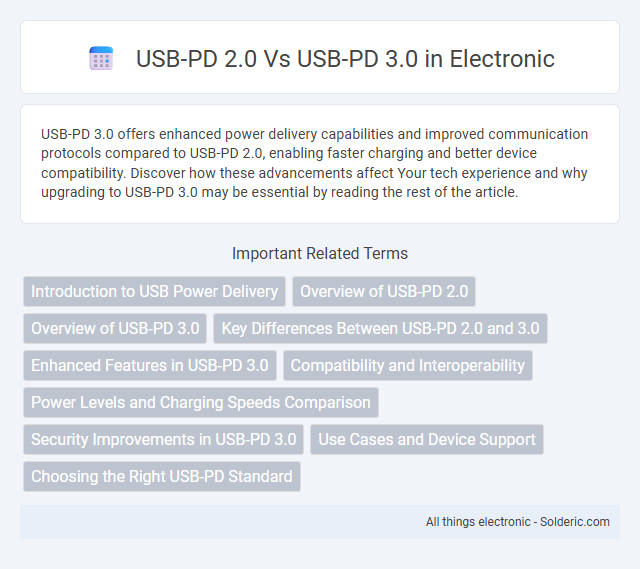USB-PD 3.0 offers enhanced power delivery capabilities and improved communication protocols compared to USB-PD 2.0, enabling faster charging and better device compatibility. Discover how these advancements affect Your tech experience and why upgrading to USB-PD 3.0 may be essential by reading the rest of the article.
Comparison Table
| Feature | USB-PD 2.0 | USB-PD 3.0 |
|---|---|---|
| Max Power Output | 100W (20V, 5A) | 100W (20V, 5A) |
| Power Rules | Basic fixed profiles | Flexible power rules, programmable power supply |
| Communication Protocol | Extended Power Range (EPR) not supported | Supports Extended Power Range (EPR) |
| Fast Role Swap | Not supported | Supported |
| Authentication | Not supported | Supports Authentication for enhanced security |
| PDO (Power Data Objects) Type | Fixed, Variable, Battery PDO | Augmented with Programmable Power Supply (PPS) |
| Backward Compatibility | Compatible with USB 2.0 and USB 3.x devices | Fully backward compatible, with added features |
Introduction to USB Power Delivery
USB Power Delivery (USB-PD) 2.0 supports up to 100W of power transfer with flexible voltage levels ranging from 5V to 20V, enabling faster charging for a variety of devices. USB-PD 3.0 introduces enhanced communication protocols for improved power negotiation, safety features like programmable power supply (PPS), and greater efficiency during power delivery. The upgrade to USB-PD 3.0 aims to provide more precise voltage and current adjustments, reducing heat and optimizing battery lifespan in modern electronics.
Overview of USB-PD 2.0
USB Power Delivery (USB-PD) 2.0 provides up to 100 watts of power transfer with improved negotiation capabilities for dynamic voltage and current adjustments. It supports multiple power profiles ranging from 5V to 20V and up to 5A, enabling faster charging and more efficient power management across various devices. USB-PD 2.0 introduced extended power range and flexible power contracts compared to earlier standards, facilitating broader compatibility and enhanced charging performance.
Overview of USB-PD 3.0
USB Power Delivery 3.0 enhances the charging experience by supporting up to 100W power transfer, dynamic voltage scaling, and improved communication between devices. This standard introduces features like Programmable Power Supply (PPS) for optimized charging speed and increased safety measures to protect your devices. USB-PD 3.0 ensures more efficient, flexible power delivery compared to USB-PD 2.0, making it ideal for faster and smarter charging solutions.
Key Differences Between USB-PD 2.0 and 3.0
USB Power Delivery (USB-PD) 3.0 offers enhanced power management compared to USB-PD 2.0, supporting up to 100W with improved efficiency and extended power profiles. While USB-PD 2.0 enables basic power negotiation up to 20V and 5A, USB-PD 3.0 introduces Programmable Power Supply (PPS) for fine-tuned voltage adjustments, reducing heat and increasing charging speed. Your devices benefit from better thermal management and broader compatibility with fast-charging standards when using USB-PD 3.0 chargers and cables.
Enhanced Features in USB-PD 3.0
USB Power Delivery 3.0 introduces advanced features such as improved power negotiation, support for higher power levels up to 100W, and enhanced communication protocols for faster and more efficient charging compared to USB-PD 2.0. It also incorporates programmable power supply (PPS) technology, enabling dynamic voltage adjustments to optimize charging speed and thermal performance. These enhancements provide greater compatibility with a wider range of devices, improving both safety and charging efficiency.
Compatibility and Interoperability
USB-PD 3.0 improves compatibility and interoperability by supporting more granular power adjustments and enhanced communication protocols compared to USB-PD 2.0. Your devices benefit from better negotiation of voltage and current levels, reducing risks of overcharging or underpowering when connected to diverse chargers. Backward compatibility ensures USB-PD 3.0 chargers work seamlessly with USB-PD 2.0 devices, maintaining broad interoperability across a wide range of hardware.
Power Levels and Charging Speeds Comparison
USB Power Delivery (USB-PD) 3.0 offers enhanced power levels and faster charging speeds compared to USB-PD 2.0, supporting up to 100W (20V/5A) with improved efficiency and more granular voltage scaling options such as 5V, 9V, 15V, and 20V for optimized energy delivery. USB-PD 3.0 introduces Programmable Power Supply (PPS) functionality that dynamically adjusts voltage and current in real-time, reducing heat generation and increasing overall charging speed, whereas USB-PD 2.0 provides fixed power profiles without PPS. These advancements in USB-PD 3.0 improve compatibility with a broader range of devices including high-power laptops and fast-charging smartphones, delivering quicker recharge times and enhanced thermal management compared to USB-PD 2.0.
Security Improvements in USB-PD 3.0
USB Power Delivery 3.0 introduces significant security enhancements compared to USB-PD 2.0, including Object-Signature-based Authentication (OSA) that prevents unauthorized devices from drawing power or accessing data. These improvements mitigate risks such as power-based malware attacks and unauthorized firmware updates by ensuring authentication of connected devices before power negotiation. USB-PD 3.0's security features establish a more robust framework to protect both data integrity and device safety in fast charging scenarios.
Use Cases and Device Support
USB-PD 2.0 primarily supports charging for smartphones, tablets, and some laptops with power delivery up to 100W, making it suitable for basic device charging and faster charging than conventional USB standards. USB-PD 3.0 enhances device compatibility with improved power rules, extended protocol support, and features like Programmable Power Supply (PPS), enabling efficient charging for a wider range of devices including gaming laptops and high-powered accessories. Your devices will benefit from USB-PD 3.0's smarter negotiation and backward compatibility, ensuring optimized and safer power delivery across various use cases.
Choosing the Right USB-PD Standard
Choosing the right USB-PD standard depends on your charging needs and device compatibility. USB-PD 3.0 offers improved power negotiation, enhanced battery protection, and supports up to 100W power delivery, making it ideal for fast-charging laptops and advanced devices. Your decision should consider whether enhanced features like Programmable Power Supply (PPS) in USB-PD 3.0 benefit your devices compared to the more basic USB-PD 2.0 standard.
USB-PD 2.0 vs USB-PD 3.0 Infographic

 solderic.com
solderic.com